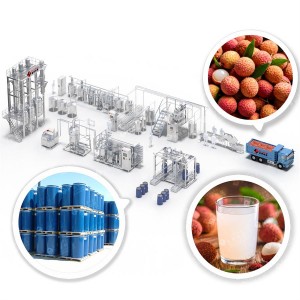Industrial Mango Processing Line
Before processing, fresh mangoes are washed and sorted to remove dirt, debris, and defective fruits. Typically, a two-stage washing system is used — bubble washer and brush washer. The bubble washer agitates water and air to clean the fruit surface, while the brush washer removes remaining impurities.
After cleaning, the mangoes are conveyed by an elevator to a sorting platform, where manual or optical sorting removes overripe, rotten, or undersized fruits. The elevator ensures stable and continuous feeding between washing and sorting, reducing manual handling and improving efficiency.
At the end of this stage, the mangoes are clean, uniform in quality, and ready for subsequent processing.




The mango peeling and destoning machine is one of the core components of the processing line. It removes the thick peel and hard seed while separating the pulp.
The process typically involves two stages: first, a breaking unit uses specially designed rollers to crush the mangoes without damaging the kernel; second, the pulp is scraped from the seed by high-speed rotating blades and separated through a perforated screen.
Under centrifugal force, the pulp passes through the sieve for further refining, while the seed and peel residues are discharged automatically.
Because mango flesh is fibrous, single-stage or double-stage designs are common. The double-stage machine refines the pulp further after the first separation, improving yield and smoothness.
After this process, peel and stones are removed, producing a coarse mango pulp ready for fine refining.




The coarse mango pulp is fed into a pulping and refining machine for further homogenization.
A dual-stage pulper is often used — the first screen removes residual peel fibers and seed fragments, while the second screen refines the texture by filtering out fibrous matter.
The resulting mango puree becomes uniform and smooth, with most coarse fibers eliminated. This step significantly increases product yield and texture quality.
In small-capacity lines, an integrated pulper-refiner may combine destoning and refining in one machine.
The refined mango puree is thick, uniform, and smooth — ideal for puree-based products or juice production.
For concentrated mango puree or juice, the refined product undergoes vacuum evaporation using multi-effect forced-circulation evaporators.
Under vacuum conditions, water evaporates at a lower temperature, preserving flavor and nutrients while improving energy efficiency through heat recovery.
The soluble solids (°Brix) of mango puree typically increase from 10–12% to 28–30% (or higher).
Concentrated products are easier to store and transport. For NFC (Not-From-Concentrate) juices, this step is skipped.
Before packaging, mango puree or juice must be pasteurized or sterilized.
A tubular UHT sterilizer is widely used for continuous, rapid heat treatment. For viscous mango puree, a tube-in-tube heat exchanger heats the product to above 95 °C (often 110–125 °C for bulk aseptic filling) and then rapidly cools it.
The temperature and holding time are adjusted depending on the product type — for example, retail juice may use 85–95 °C pasteurization to retain flavor.
The system precisely controls time and temperature to ensure commercial sterility while preserving taste.
Sterilized mango pulp or juice is now ready for aseptic packaging.
Sterilized products are filled under aseptic conditions.
An aseptic bag filler transfers mango puree, pulp, or juice into pre-sterilized aluminum-plastic bags placed inside 200 L steel drums.
The filling chamber is maintained sterile by steam or UV disinfection, and the process is flow-meter controlled for accuracy.
Aseptic-filled concentrated mango puree can be stored for up to 18–24 months under refrigeration.
For non-concentrated pulp, small bag-in-box (3–5 kg) or tin cans are used.
For consumer beverages, hot-fill (around 85 °C) or cold aseptic filling into PET/glass bottles or Tetra Pak cartons ensures long shelf life without preservatives.
The line is equipped with a CIP cleaning system to automatically wash and sanitize pipelines and fillers after production.
Mango Pulp/Puree: Thick, unclarified pulp retaining natural fibers. Process: washing → destoning → pulping/refining → (optional concentration) → sterilization → aseptic filling. No enzymolysis or clarification required.
Mango Juice: Includes clear and cloudy juice. Clear juice requires enzymatic and clarification steps; cloudy juice (nectar) retains pulp and needs homogenization. Process: washing → destoning → pulping → enzymolysis/clarification or homogenization → blending → deaeration → sterilization → filling.
Concentrated vs. Non-Concentrated: Concentrated products use vacuum evaporation; NFC products skip concentration for fresher flavor but require cold storage.
A well-designed mango processing line can flexibly produce multiple product types — puree, pulp, clear juice, or nectar — meeting diverse market demands with high automation and product quality that retains the natural aroma, color, and nutrients of fresh mangoes.












